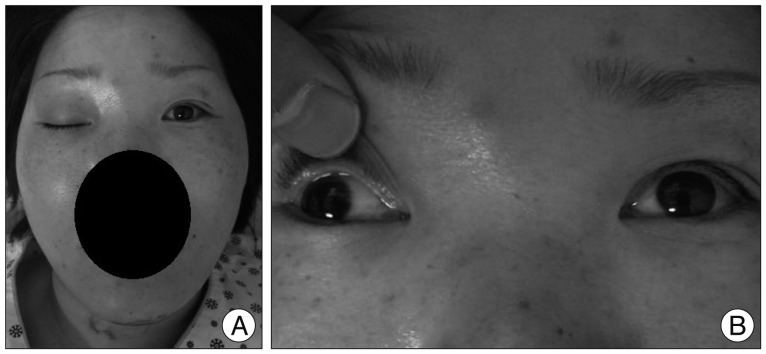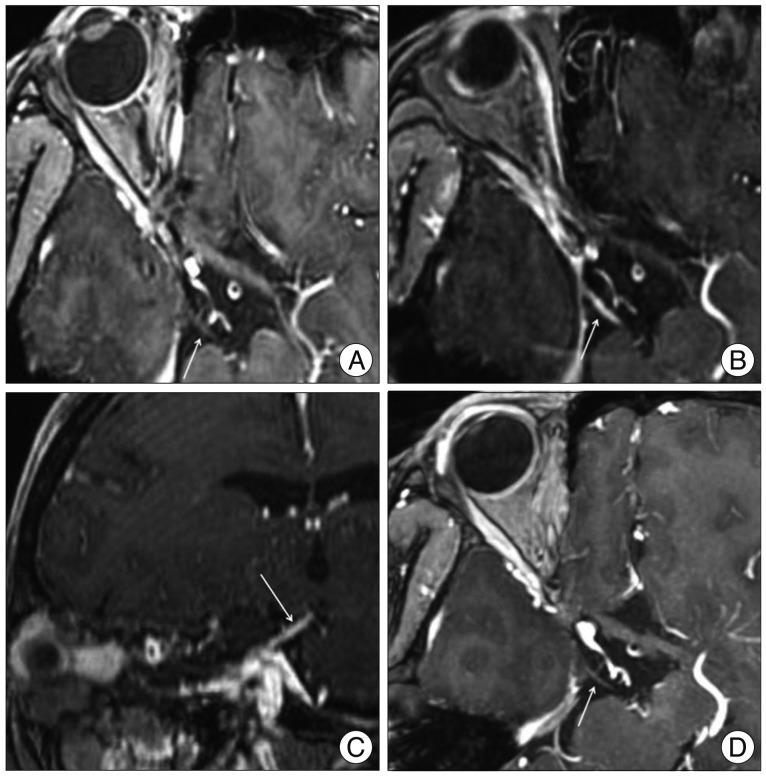J Korean Neurosurg Soc.
2013 Nov;54(5):434-436. 10.3340/jkns.2013.54.5.434.
Isolated Oculomotor Nerve Palsy Following Minor Head Trauma : Case Illustration and Literature Review
- Affiliations
-
- 1Department of Neurosurgery, Dongsan Medical Center, Keimyung University School of Medicine, Daegu, Korea. bach1158@dsmc.or.kr
- 2Department of Radiology, Dongsan Medical Center, Keimyung University School of Medicine, Daegu, Korea.
- KMID: 2138363
- DOI: http://doi.org/10.3340/jkns.2013.54.5.434
Abstract
- Isolated oculomotor nerve palsy (ONP) attributable to mild closed head trauma is a distinct rarity. Its diagnosis places high demands on the radiologist and the clinician. The authors describe this condition in a 36-year-old woman who slipped while walking and struck her face. Initial computed tomography did not reveal any causative cerebral and vascular lesions or orbital and cranial fractures. Enhancement and swelling of the cisternal segment of the oculomotor nerve was seen during the subacute phase on thin-sectioned contrast-enhanced magnetic resonance images. The current case received corticosteroid therapy, and then recovered fully in 13 months after injury. Possible mechanism of ONP from minor head injury is proposed and previous reports in the literature are reviewed.
Keyword
MeSH Terms
Figure
Reference
-
1. Bruce BB, Biousse V, Newman NJ. Third nerve palsies. Semin Neurol. 2007; 27:257–268. PMID: 17577867.
Article2. Chen CC, Pai YM, Wang RF, Wang TL, Chong CF. Isolated oculomotor nerve palsy from minor head trauma. Br J Sports Med. 2005; 39:e34. PMID: 16046322.
Article3. Dhaliwal A, West AL, Trobe JD, Musch DC. Third, fourth, and sixth cranial nerve palsies following closed head injury. J Neuroophthalmol. 2006; 26:4–10. PMID: 16518159.
Article4. Elston JS. Traumatic third nerve palsy. Br J Ophthalmol. 1984; 68:538–543. PMID: 6743622.
Article5. Eyster EF, Hoyt WF, Wilson CB. Oculomotor palsy from minor head trauma. An initial sign of basal intracranial tumor. JAMA. 1972; 220:1083–1086. PMID: 4537257.
Article6. Hosoya T, Adachi M, Yamaguchi K, Yamaguchi K, Kato T, Sugai Y. Abducens nerve enhancement demonstrated by multiplanar reconstruction of contrast-enhanced three-dimensional MRI. Neuroradiology. 2001; 43:295–301. PMID: 11338412.
Article7. Janssen K, Wojciechowski M, Poot S, De Keyser K, Ceulemans B. Isolated abducens nerve palsy after closed head trauma : a pediatric case report. Pediatr Emerg Care. 2008; 24:621–623. PMID: 18797373.8. Kaido T, Tanaka Y, Kanemoto Y, Katsuragi Y, Okura H. Traumatic oculomotor nerve palsy. J Clin Neurosci. 2006; 13:852–855. PMID: 16978866.
Article9. Kruger M, Noel P, Ectors P. Bilateral primary traumatic oculomotor nerve palsy. J Trauma. 1986; 26:1151–1153. PMID: 3795318.
Article10. Kuo LT, Huang AP, Yang CC, Tsai SY, Tu YK, Huang SJ. Clinical outcome of mild head injury with isolated oculomotor nerve palsy. J Neurotrauma. 2010; 27:1959–1964. PMID: 20799883.
Article11. Levy RL, Geist CE, Miller NR. Isolated oculomotor palsy following minor head trauma. Neurology. 2005; 65:169. PMID: 16009916.
Article12. Liu YT, Lee YC, Liu HC. Isolated oculomotor nerve palsy due to head injury. J Chin Med Assoc. 2004; 67:149–151. PMID: 15181969.13. Mark AS, Casselman J, Brown D, Sanchez J, Kolsky M, Larsen TC 3rd, et al. Ophthalmoplegic migraine : reversible enhancement and thickening of the cisternal segment of the oculomotor nerve on contrast-enhanced MR images. AJNR Am J Neuroradiol. 1998; 19:1887–1891. PMID: 9874541.14. Memon MY, Paine KW. Direct injury of the oculomotor nerve in craniocerebral trauma. J Neurosurg. 1971; 35:461–464. PMID: 5133594.
Article15. Muthu P, Pritty P. Mild head injury with isolated third nerve palsy. Emerg Med J. 2001; 18:310–311. PMID: 11435377.
Article16. Nagaseki Y, Shimizu T, Kakizawa T, Fukamachi A, Nukui H. Primary internal ophthalmoplegia due to head injury. Acta Neurochir (Wien). 1989; 97:117–122. PMID: 2718803.
Article
- Full Text Links
- Actions
-
Cited
- CITED
-
- Close
- Share
- Similar articles
-
- Bilateral Oculomotor Nerve Palsy after Head Trauma: A Case Report
- Pituitary Apoplexy Presenting as Isolated Oculomotor Nerve Palsy
- Isolated Oculomotor Nerve Palsy Caused by Onodi Cell Sinusitis
- A Case of Isolated Complete Oculomotor Nerve Palsy Following Endoscopic Sinus Surgery
- Sinocutaneous Fistula Induced by Long-Standing, Retained, Non-Absorbable Nasal Packing in The Paranasal Sinus




